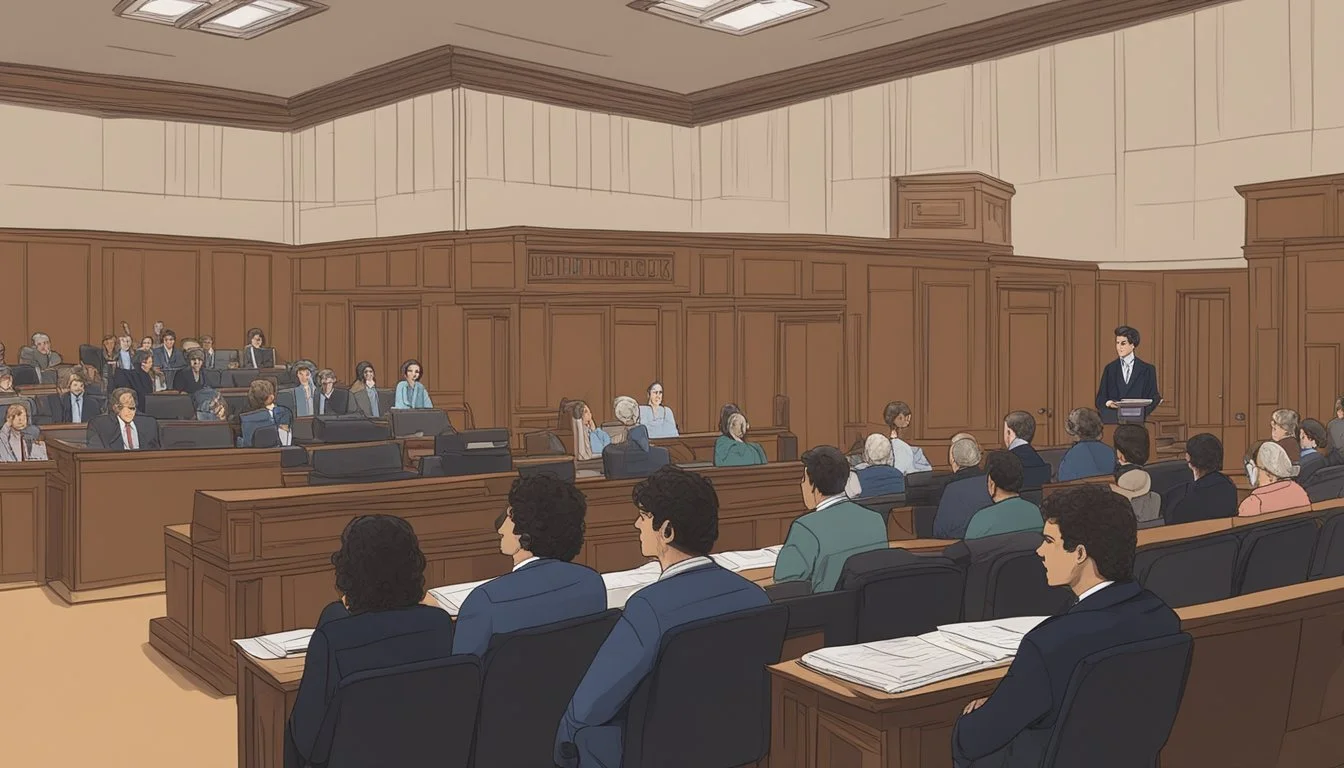Scoring a Tragedy: Music Choices in the Menendez Brothers' Documentary
Emotional Impact and Audience Perception
The Netflix documentary "Monsters: The Lyle and Erik Menendez Story" has captivated audiences with its retelling of the infamous Menendez brothers case. One aspect that stands out is the soundtrack, which plays a crucial role in setting the tone and atmosphere of the series.
The music choices in the Menendez brothers documentary serve as a powerful tool to evoke the emotions and cultural context of the late 1980s and early 1990s. From Kenny G's "Songbird" to Milli Vanilli's "Girl You Know It's True," the soundtrack transports viewers back to the era when the shocking murders took place.
The selection of songs goes beyond mere nostalgia, often providing subtle commentary on the unfolding events. The documentary's creators have carefully curated a mix of popular hits and lesser-known tracks to underscore key moments in the Menendez brothers' story, enhancing the viewer's understanding of this complex and tragic case.
Origins of the Menendez Family Tragedy
The Menendez family's story began with promise but ended in violence. José and Kitty Menendez built a life of wealth and status, raising their sons Lyle and Erik in Beverly Hills. Yet beneath the surface, dark undercurrents would ultimately lead to shocking devastation.
The Menendez Household
The Menendez family lived in an opulent Beverly Hills mansion, projecting an image of success and affluence. José, a Cuban immigrant, had risen to become a powerful entertainment executive. Kitty, his wife, managed their lavish household. Their sons Lyle and Erik attended elite private schools and enjoyed many privileges.
On the surface, they seemed to embody the American dream. But behind closed doors, tensions simmered. José was known for his demanding and controlling nature. He pushed his sons relentlessly, expecting perfection in academics and athletics. This pressure created strain within the family dynamic.
José and Kitty Menendez: A Closer Look
José Menendez built his career through ambition and ruthlessness. He climbed the corporate ladder in the entertainment industry, eventually becoming CEO of LIVE Entertainment. His drive for success and wealth was all-consuming. Kitty, once an aspiring singer, dedicated herself to supporting her husband's ambitions.
Their relationship was complex. José could be charming but also domineering. Kitty struggled with depression and substance abuse issues. The couple's conflicts often played out in front of their sons. This unstable environment shaped Lyle and Erik's upbringing in profound ways.
José's strict parenting style bordered on abusive at times. He used threats of disinheritance to control his sons. This toxic family dynamic set the stage for the tragedy that would ultimately unfold.
The Crime That Shocked Beverly Hills
On August 20, 1989, a brutal double murder rocked the affluent community of Beverly Hills. Lyle and Erik Menendez, aged 21 and 18 respectively, shot and killed their parents José and Kitty Menendez in their luxurious mansion.
The Night of the Murder
The Menendez brothers burst into the den of their family's Beverly Hills home armed with shotguns. José and Kitty were watching TV when the attack occurred. Lyle and Erik fired a total of 14 shots at close range, leaving their parents dead.
The brutality of the crime stunned neighbors in the upscale area. Initially, the brothers claimed they were not home at the time of the murders. They told police they had gone to see a movie that evening.
Investigation and Evidence
Police found no signs of forced entry at the mansion. This led investigators to suspect an inside job. Key evidence included:
Shotgun shells at the crime scene
Blood-spattered walls and furniture
The brothers' suspicious behavior after the murders
Lyle and Erik went on a spending spree in the months following their parents' deaths. They bought expensive cars, watches, and properties. This extravagant lifestyle raised further suspicions about their involvement.
The Murder Trial
The Menendez brothers were arrested in March 1990. Their trial began in 1993 and captivated the nation. Key aspects of the trial included:
The brothers' claim of self-defense due to years of abuse
Graphic crime scene photos presented to the jury
Testimony from family members and psychologists
The first trial ended in a hung jury. A second trial in 1995 resulted in both brothers being convicted of first-degree murder. They were sentenced to life in prison without the possibility of parole.
Musical Narratives in True Crime Storytelling
Music in true crime documentaries shapes audience perceptions and emotional responses. Carefully chosen scores and song selections enhance storytelling, provide subtext, and create a lasting impact on viewers.
Scoring the Story: Emotional Resonance
Composers for true crime documentaries craft musical themes that reflect the emotional journey of the subjects. Tense, suspenseful tracks build anticipation during key moments. Melancholic melodies underscore tragic events or victim stories. Upbeat rhythms might accompany moments of hope or justice.
The Menendez brothers documentary likely employs a range of musical styles to capture the complex emotions surrounding the case. Subtle piano pieces could evoke sympathy, while discordant strings might hint at underlying family dysfunction.
Music choices can guide viewers' emotional responses without overtly manipulating them. A skilled composer balances enhancing drama with maintaining objectivity in presenting factual events.
Music Choices and Subtext
Song selections in true crime documentaries often carry deeper meanings. Filmmakers may use popular songs from the era to establish time and place. Lyrics can provide commentary on events or characters' mindsets.
In the Menendez case, the brothers' song choice at their parents' funeral adds a layer of intrigue. The documentary might explore this moment through musical analysis, considering how the song reflects the complex family dynamics at play.
Instrumental pieces can also convey subtext. Minor key compositions might suggest darkness or deceit, while major key themes could represent innocence or redemption. These musical cues subtly influence viewer interpretations of events and individuals.
The Role of Soundtracks in Documentary Features
Soundtracks in documentary features serve multiple functions beyond emotional impact. They help maintain pacing and flow between scenes. Strategic use of silence can be as powerful as music in creating tension or allowing reflection.
Original scores for true crime documentaries often blend traditional orchestral elements with modern electronic sounds. This approach creates a unique auditory identity for the film while appealing to contemporary audiences.
Music can also act as a narrative device, bridging gaps in the story or highlighting key themes. Recurring motifs might represent specific characters or events, providing continuity throughout the documentary. The Menendez brothers' story likely features distinct musical themes for each brother, their family life, and the trial proceedings.
Unveiling the Personal and the Monster
The Menendez brothers case blurs the line between victim and perpetrator. Their portrayal in media reveals complex layers of family dynamics, trauma, and public perception.
Portraying Lyle and Erik
Lyle and Erik Menendez's depiction in documentaries and dramas often walks a fine line. Some portrayals emphasize their privileged upbringing and the brutality of their crime. Others highlight alleged abuse and psychological trauma.
Actors playing the brothers face the challenge of conveying both vulnerability and capacity for violence. They must capture the essence of young men who committed a horrific act while potentially being victims themselves.
Music choices in these portrayals can subtly influence audience perception. Somber tones may evoke sympathy, while discordant sounds can underscore darker aspects of their personalities.
Monsters or Victims: Public Perception
The Menendez case sparked intense debate about the nature of evil and victimhood. Initial public reaction largely viewed the brothers as cold-blooded killers.
As details of alleged abuse emerged, some began to see Lyle and Erik as victims of a toxic family environment. This shift in perception was reflected in media coverage and courtroom strategies.
The term "monster" became a contentious label. Some argued it oversimplified a complex situation, while others felt it aptly described their actions.
Public opinion remains divided. The case continues to challenge notions of guilt, innocence, and the impact of childhood trauma on adult behavior.
Behind the Scenes of the Documentary
The Menendez Brothers documentary offers a unique glimpse into the production process and creative decisions that shaped the final film. From extensive interviews to new evidence, the filmmakers crafted a compelling narrative that delves deep into this infamous case.
Interviews and Story Construction
Director Alejandro Hartmann conducted exclusive interviews with Lyle and Erik Menendez, providing rare insight into their perspectives. These audio interviews formed the backbone of the documentary's narrative structure. Hartmann carefully selected and edited segments to create a coherent storyline.
The production team also spoke with key figures involved in the case, including prosecutor Pam Bozanich. Her firsthand account of leading the prosecution added valuable context to the legal proceedings.
To maintain balance, the filmmakers sought input from various sources, including family friends, experts, and investigators. This multi-faceted approach helped present a comprehensive view of the events surrounding the murders.
New Evidence and Revelations
The documentary team uncovered previously undisclosed information during their research. This new evidence shed light on aspects of the case that were not widely known before.
One significant revelation involved the brothers' relationship with their parents. The film explored the complex family dynamics and alleged abuse, providing viewers with a more nuanced understanding of the circumstances leading up to the crimes.
The filmmakers also examined the cultural context of the late 1980s, including the influence of popular music like Milli Vanilli. This exploration helped frame the brothers' experiences within the broader societal landscape of the time.
Creative License: The Filmmakers' Approach
Hartmann, along with producers Ian Brennan and Ryan Murphy, made conscious decisions about how to present the story. They employed a mix of archival footage, reenactments, and stylized elements to engage viewers.
Music played a crucial role in setting the tone throughout the documentary. The team carefully selected tracks that evoked the era and enhanced emotional impact without overshadowing the narrative.
The filmmakers faced challenges in balancing factual accuracy with storytelling. They strived to present information objectively while still creating a compelling viewing experience. This required careful consideration of pacing, visual elements, and narrative structure.
Legal and Societal Aftermath
The Menendez brothers case profoundly impacted the legal system and public perception of high-profile criminal trials. Their convictions and subsequent incarceration sparked debates about justice, family dynamics, and media influence on court proceedings.
Trial Outcomes and Life in Prison
Lyle and Erik Menendez were found guilty of first-degree murder in 1996. The jury rejected their claims of self-defense and abuse. Both brothers received life sentences without the possibility of parole.
In prison, the Menendez brothers adapted to their new reality. They were initially held in separate facilities but later reunited at Richard J. Donovan Correctional Facility in San Diego.
Despite their circumstances, they've maintained some semblance of normalcy. Lyle married twice while incarcerated. Erik found solace in writing and advocacy for youth programs.
Their case continues to draw public interest decades later. Several documentaries and TV specials have revisited the murders, keeping the Menendez name in the spotlight.
Media Impact on Criminal Cases
The Menendez trial highlighted the growing influence of media on high-profile criminal cases. Extensive television coverage turned the proceedings into a national spectacle.
Defense attorney Leslie Abramson became a media figure herself, known for her fierce advocacy and distinctive hairstyle. Her passionate defense strategy captivated audiences.
The trial's televised nature raised questions about fair trials in the age of mass media. Critics argued that such exposure could bias potential jurors and influence public opinion.
Prosecutors faced challenges in maintaining case integrity amidst intense scrutiny. The media frenzy surrounding the trial set a precedent for future high-profile criminal cases.
This case underscored the need for careful management of media access in courtrooms. It sparked discussions about balancing public interest with the rights of the accused.
The Broader Context of the Menendez Brothers' Story
The Menendez brothers case intertwines family trauma, wealth, and societal perceptions. It sparked debates on abuse, justice, and media portrayal of high-profile crimes.
Family Dynamics and Abuse
The Menendez family presented a facade of success and prosperity. Behind closed doors, a darker reality unfolded. Lyle and Erik Menendez accused their father, Jose, of sexual abuse.
This allegation became central to their defense strategy. It highlighted the complex nature of familial relationships and the long-term effects of trauma.
The brothers claimed their actions were a response to years of mistreatment. This defense challenged societal assumptions about wealthy families and hidden abuse.
The Glamour and the Dark Side of Beverly Hills
Beverly Hills, known for luxury and celebrity, served as the backdrop for this tragedy. The Menendez family's mansion symbolized their outward success.
The contrast between their affluent lifestyle and the brutal crime shocked the public. It exposed the potential darkness lurking beneath seemingly perfect exteriors.
This case forced a re-examination of the "American Dream" narrative. It showed how wealth and status could mask deep-seated issues and dysfunction.
Implications for True Crime Narratives
The Menendez case significantly impacted true crime storytelling. It blurred lines between victim and perpetrator, challenging simple narratives.
Media coverage evolved from initial shock to more nuanced exploration of motives. The case sparked discussions on mental health, abuse cycles, and judicial fairness.
Documentaries and dramatizations continue to revisit this story. They often focus on the brothers' claims of abuse and the complexities of family dynamics.
This ongoing interest reflects society's fascination with understanding the psychological factors behind shocking crimes.
The Documentary's Place in Modern Media
The Menendez Brothers documentary on Netflix reflects shifting trends in true crime content and streaming platform dominance. It showcases the evolving landscape of media consumption and cultural discourse.
Streaming Services and Audience Reach
Netflix's release of the Menendez Brothers documentary marks a significant moment in true crime storytelling. The streaming giant's global platform ensures widespread accessibility, potentially reaching millions of viewers worldwide.
This broad distribution amplifies the documentary's impact, sparking renewed interest in the case. The convenience of on-demand viewing allows audiences to engage with the content at their own pace, fostering deeper analysis and discussion.
Netflix's algorithm-driven recommendations also play a role in exposing the documentary to viewers who may not have actively sought it out. This targeted approach helps expand the audience beyond true crime enthusiasts.
Cultural Reflections and True Crime
The documentary taps into the ongoing fascination with true crime narratives in popular culture. It revisits a case that captivated the public in the 1990s, offering new perspectives and insights.
The film's exploration of the Menendez brothers' story reflects society's continued interest in understanding complex criminal cases. It prompts viewers to reconsider past judgments and examine the nuances of high-profile trials.
True crime documentaries often serve as a mirror to societal values and legal systems. This production is no exception, encouraging critical thinking about family dynamics, wealth, and justice.
The inclusion of cultural touchstones like Milli Vanilli's "Blame It On the Rain" adds context to the era. It helps viewers connect with the time period and understand the broader cultural landscape surrounding the case.









